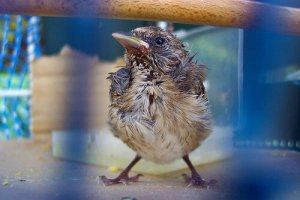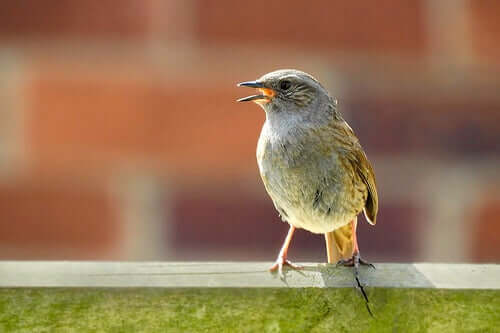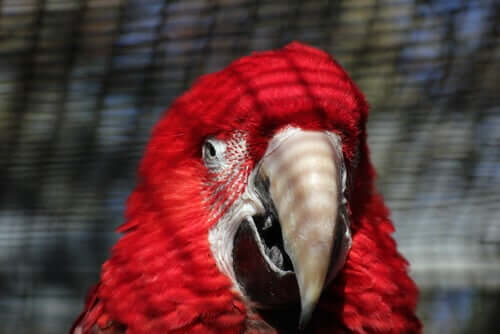The Most Common Diseases in Pet Birds


Written and verified by the lawyer Francisco María García
Pet birds are intelligent, sociable animals, and they’re also vulnerable to common diseases. So, knowing how to recognize the first signs of trouble is important for maintaining their well-being.
The most common diseases in pet birds
The term “bird” encompasses a huge and extremely diverse group of vertebrate animals adapted to aerial life. Each bird species has a specific type of body and evolved in a certain way according to the environment where they grew up.
Each bird species has a greater or lesser sensitivity to various types of microorganisms, toxins, or food substances. Not to mention their genetic tendency to certain diseases according to their breed and/or lineage.

Accidental blows
Even though these aren’t exactly diseases, accidental blows are one of the main causes of death among domestic birds. Generally, these happen in wild birds and in environments that aren’t properly conditioned for their needs.
There are no specific symptoms. However, birds who get hit hard often have difficulties flying together with fractures and even wing damage.
Pecking is one of the most common diseases in pet birds
This is a psychological disease in which a bird plucks the feathers from its chest, back, and belly. It’s usually due to stress, skin infections, and parasites.
Scabies or mite allergy
Mites can cause skin allergies and scabies in domestic birds. These are highly contagious conditions and require immediate treatment. So, you must consult a vet immediately if you think you recognize any of the symptoms.
The formation of white scabs or warts on the eyes, nostrils, and legs are the main symptoms of this condition.
The best form of prevention is to maintain proper hygiene of the animal’s cage. Treatment usually consists of topical medications such as ointments and creams based on sulfur. It’s mainly about reducing inflammation and promoting the regeneration of the bird’s epithelial cells.
Red lice infestation
Red lice can easily infest domestic birds and cause serious damage to their skin and plumage.
The presence of these parasites usually leads to severe itching so the bird might compulsively scratch itself. Another symptom that happens as the parasites progress is the loss of vitality that leads to lethargy.
There are specific products for the prevention of red lice and mites in parrots and other pet birds. You must spray these products periodically on the body of your bird in order to prevent red lice from jumping on board. In addition, you must properly disinfect their cage together with all of their accessories and even your entire home if possible.
Intestinal parasites
Direct contact and ingestion of waste, be it their own or other birds’ is the perfect setting for the entry and proliferation of intestinal parasites, mainly worms, and Ascaris.
The main form of prevention is to properly sanitize the cage and keep it from resting directly on the floor or the ground. This is so the animal won’t be in direct contact with their feces.
Candidiasis is one of the most common diseases in pet birds
Like humans, birds can also develop Candidiasis, and the most common symptoms are diarrhea and vomiting. As the disease progresses the animal will lose its appetite and radically lose weight and become malnourished.
You must consult your veterinarian before opting for any palliative treatment.
Psittacine beak and feather disease (PBFD)
PBFD is an infectious and viral disease that’s also known as French molt.
The main symptom is an abnormality in the skin and feathers of the affected bird. For example, their plumage begins to grow abnormally with ruffled feathers or they just don’t regenerate. In more severe cases, the animal may lose all of its plumage, in addition to deformations in its beak.

You must consult your vet immediately if you notice any of these symptoms. This is because viral infections that afflict birds are difficult to treat in advanced cases. So, early diagnosis is crucial when it comes to saving your bird’s life.
Intoxication
This is another biggie when it comes to pet bird diseases.
It mainly happens when the animal accidentally ingests food or objects left within its reach. These are some of the toxic substances:
- Lead: This is usually present in jewelry, paintings, lamps, and toys.
- Zinc: This one is commonly found in cables, screws and even in certain tools.
- Poisonous foods: Substances like chocolates and sweets, industrialized foods, sausages, fried foods, salt, sugar, coffee and other caffeinated products, high-fat milk, and dairy.
As you can see, pet bird diseases often happen asymptomatically.
Thanks for reading.
This text is provided for informational purposes only and does not replace consultation with a professional. If in doubt, consult your specialist.